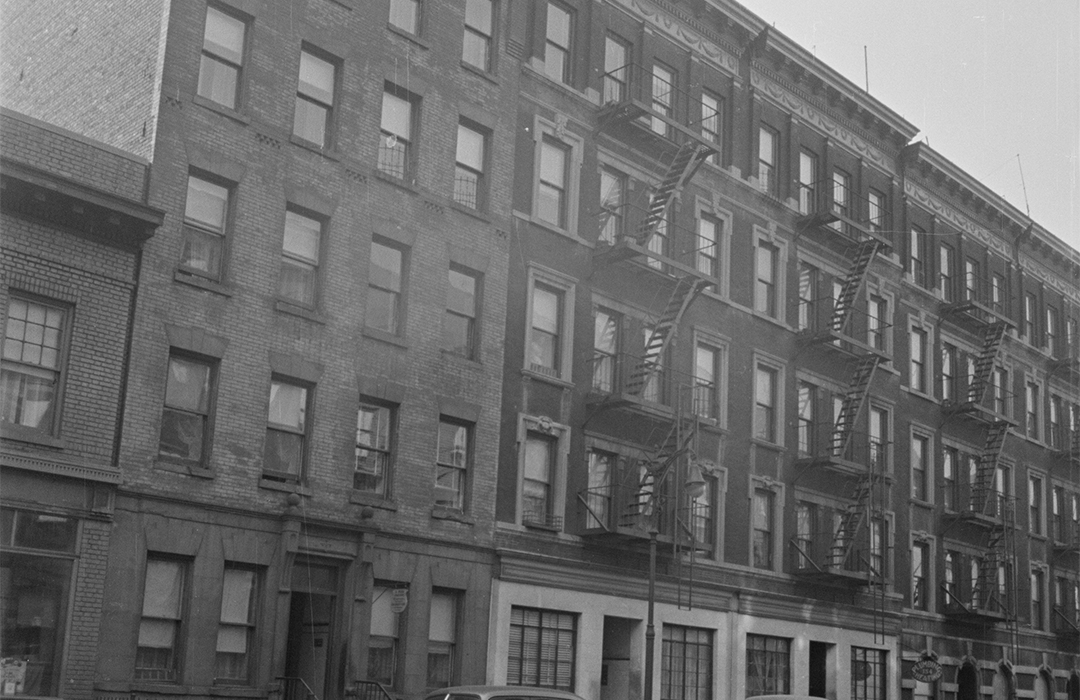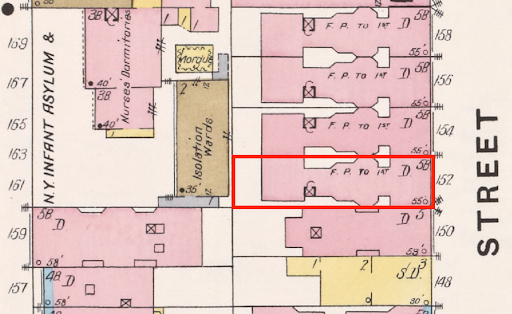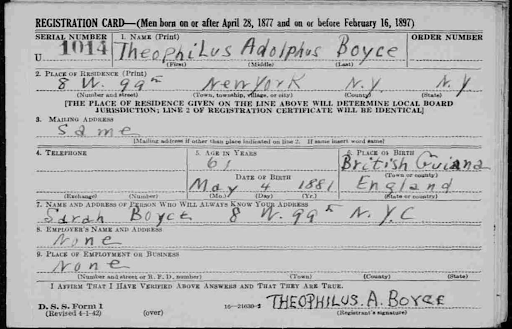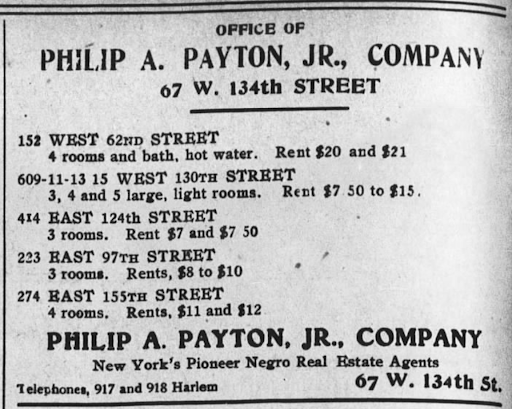
152 West 62nd Street
by Jessica Larson
Designed in the Renaissance Revival style by architect Frederick Charles Zobel, 152 West 62nd Street was residential building constructed in 1899. Zobel was a prolific designer of commercial and residential structures and was credited as designing features that advanced skyscraper construction. Zobel was also listed as the original owner of the building.
The building was five stories and a basement. A tax photo from the 1940s suggests that the ground floor might have been converted to a commercial space at some point. The building is not included in the 1900 federal census; as the permit was filed in 1899, the building likely was not inhabited yet, or possibly still under construction. However, the neighbors in buildings surrounding it were largely European immigrants as well as native-born Americans, all white. Many came from Germany, Ireland, and Canada. Directly behind 152 West 62nd Street was the New York Infant Asylum and Maternity Hospital, as well as buildings that were home to Black and Chinese tenants.
In 1910, 152 West 62nd Street was finally included in the census. All residents in the building were Black, hailing from the United States, the West Indies, and, curiously, South America. The lodger from South America was Theophilus Adolphus Boyce, a 28-year-old man, also listed as Black. His World War I draft registration card from 1917-1918 listed his birthplace as Great Britain. His World War II registration card from 1942 provides more clarity, stating that he was born in British Guiana, explaining why he was listed as being from South America. Boyce might have been the descendant of enslaved Africans, imported during the Transatlantic Slave Trade by either the Dutch or British. A 1908 issue of the Official Gazette of British Guiana listed a Theophilus Adolphus Boyce as having previously lived in Georgetown, the capital of the colony. In the 1910 census, Boyce was recorded as working as a clerk for the railroad in New York.
In 1911, newspaper ads show that the building at 152 West 62nd Street was managed by the Philip A. Payton, Jr. Company, a pioneering Black real estate firm. Philip A. Payton, Jr. was a prominent Black businessman and integral to the development of Harlem as a Black cultural and economic mecca. He has popularly been referred to as the “Father of Harlem.” While San Juan Hill was still heavily populated by Black residents, Payton managed many buildings in the neighborhood too. 1911 ads list rent for 152 West 62nd Street as being $20 and $21 a month –around $640 in 2025. This was on the higher end of standard pricing for comparable apartments.
152 West 62nd Street was managed by the Philip A. Payton, Jr. Company, a pioneering Black real estate firm.
In 1920, surprisingly, the building no longer had any Black tenants. Instead, they were replaced by white Americans and European immigrants. Many came from Eastern Europe, such as Poland and Russia, and were Yiddish-speaking Jews. For example, husband and wife Max and Matilda Cohen, who came from Russia. Max was 28 and was a sailor; Matilda was 21 and did not have an occupation listed. By 1920, many Black residents of San Juan Hill had left to resettle in Harlem; however, the block on West 62nd Street still had many Black residents, some from the Caribbean. The area became more heavily populated by Jewish residents as the century wore on.
In 1930, 18 people lived in the building. Two French families rented apartments, as well as tenants from Poland, various U.S. states, and the West Indies. Curiously, the West Indies tenants –Henry (31-years-old) and Elsiff (21-years-old) Randolph –were white. Usually, immigrants from the Caribbean were listed as Black. The two were likely the descendants of British colonists. They had two sons: Arthur, 3 years old, and Kenneth, 1 year old. Henry supported the family as a salesman of hardware.
These demographics didn’t change much over the next ten years. In 1940, tenants originated from England, France, Greece, Ireland, and the United States. Tenant Carl Hopkins, a 33-year-old man from Buckley, Michigan, was a member of the New York National Guard, for which he was stationed in Colón in the Panama Canal Zone, along with his wife, Mabel, their 2-year-old son, Fred, and his 15-year-old stepson, Walter.
152 West 62nd Street was omitted from the 1950 census. Many of the homes in San Juan Hill were in complete disrepair and uninhabitable; this helped justify city officials’ efforts to have the neighborhood declared a slum and demolished to make way for the Lincoln Square Renewal Project, which included construction of Lincoln Center for the Performing Arts, Juilliard, Fordham University, and commercial and residential structures. 152 West 62nd Street became part of the Fordham University complex, which opened in 1961.
Resources:
1900 United States Federal Census, New York, Borough of Manhattan, Enumeration District 453, Election District 8, Ward 19, image 13 of 18. Familysearch.com
1910 United States Federal Census, New York, Borough of Manhattan, Enumeration District 1318, Ward 22, image 4 of 38. Familysearch.com
1920 United States Federal Census, New York, Borough of Manhattan, Enumeration District 455, Assembly District 5, image 63 of 76. Familysearch.com
1930 United States Federal Census, New York, Borough of Manhattan, Enumeration District 372, Ward 7, image 48 of 56. Familysearch.com
1940 United States Federal Census, New York, Borough of Manhattan, Enumeration District 31-373, Assembly District 5, image 2 of 30. Familysearch.com
Authority of His Excellency the Governor. The Official Gazette of British Guiana 30 (Jul-Dec. 1909): p. 884.
“Frederick C. Zobel.” New York Times. Nov. 21, 1943: p. 56.
McGruder, Kevin. Philip Payton: The Father of Black Harlem. New York: Columbia University Press, 2021.
“New York, New York City, World War II Draft Registration Cards, 1940-1947”, FamilySearch, Entry for Carl Edwin Hopkins and NY Woodworking Corp.
“Office of Philip A. Payton, Jr., Company” (ad). The New York Age. Oct. 12, 1911: p. 2.
Jessica Larson is a PhD Candidate in the Department of Art History, The Graduate Center, CUNY. She is also the Joe and Wanda Corn Predoctoral Fellow at the Smithsonian American Art Museum & National Museum of American History





